Mold Remediation
Recent reports of mold remediation projects shutting down schools or office buildings have raised awareness regarding the potential hazards of interior mold contamination. While scientists still have much to learn regarding the danger molds may present, some basic knowledge about interior mold prevention and remediation has been established. Check out the list of resources and supplies below to help with mold remediation in your workplace
Mold can cause many health effects. For some people, mold can cause a stuffy nose, sore throat, coughing or wheezing, burning eyes, or skin rash. People with asthma or who are allergic to mold may have severe reactions. Immune-compromised people and people with chronic lung disease may get infections in their lungs from mold.
There is always some mold around. Molds have been on the Earth for millions of years. Mold can get in your home through open doors, windows, vents, and heating and air conditioning systems. Mold in the air outside can be brought indoors on clothing, shoes, bags, and even pets.
Mold will grow where there is moisture, such as around leaks in roofs, windows, or pipes, or where there has been a flood. Mold grows on paper, cardboard, ceiling tiles, and wood. Mold can also grow in dust, paints, wallpaper, insulation, drywall, carpet, fabric, and upholstery.

About Mold & Mold Removal
It is a fact that molds produce allergens and irritants that can cause exposed individuals to experience symptoms of hay fever i.e. sneezing, runny nose, skin rashes, irritated eyes as well as nose, throat and lung ailments.
Many toxic molds, including black mold, produce poisonous substances called mycotoxins. These toxins interfere with cell structures and processes, and have the potential to cause serious health issues. Their effects to the body have been documented using controlled conditions in a laboratory. Mycotoxins have been proven to be present indoors with victims suffering from: pulmonary hemorrhage or pulmonary hemosiderosis (primarily in infants), headaches and other flu-like symptoms, nose bleeds, immune system suppression (resulting in increased numbers of infections), hair loss, chronic fatigue, psychological depression, diarrhea, sore throats and dermatitis.
Mold Inspection
If you have mold or believe you have mold, an inspection is a beginning point. For a nominal fee we can come on site and perform an inspection, taking into consideration the history of the property, current dampness, the moisture source, affected materials, and suspected affected areas. We have a variety of moisture detection meters and devices, and experience in looking for and detecting mold.
Mold Testing
Mold exposure is typically from spores that get airborne and we breath them in. Mold spores are so small they are not visible in the air. Mold testing can measure and document the quantity and varieties of mold in the air. This type of information can be helpful in determining the scope of work necessary; documenting the results of the mold removal and proof that the space is clean and safe. Black, Toxic and Alergenic Molds can cause serious health problems.
Mold and Mildew
Mold is most prolific between 65°F and 85°F. Building interiors can provide a “prime” environment for growth and reproduction of mold, mildew and bacteria. All are parasitic and rely on organic matter for food. Mold breaks down organic matter and its food sources such as wood, paper, drywall, paneling, and ceiling tiles. Decaying organic jute backing on carpets coupled with warm humid air, creates an ideal environment for reproduction.

A Basic Guide To Mold Remediation
understands that mold growth and the subsequent remediation processes is important for businesses and homeowners. Knowledge of these steps will help teams of professional mold remediation specialists
Be aware of sources of moisture in your home
Mold growth is highly dependent upon humidity, leaks, floods, or any other major method access to water in your home. Thus, it is important to be able to identify any possible sources of moisture into your home, like cracks or leaks in your roof, ceiling, walls, or foundation. Even before you can detect it, mold can be present in your home in places where you cannot see or smell. But if you are aware of all the sources of moisture in your home, mold removal specialists will be able to track the moisture source and locate the entirety of mold growth, not just the parts that are immediately visible.
Take pictures and video of any discernable mold
Prior to mold removal services, make sure you take pictures and/or video of any detectable mold within your home that you want to remediation team to eliminate. For your safety, make sure you wear protective equipment while you are in areas exposed to mold, like respirators, eye goggles without vents, and rubber gloves that extend at least to mid-forearm. This will help the remediation team have concrete targets for remediation and begin to predict the entirety of the presence of mold in your home. This documentation helps point to larger trends of mold growth and is important for your own records as a homeowner when dealing with insurance adjusters later on.
Create a plan for potential relocation
Mold can be a major inconvenience not only because of the potential for illness but also because more significant outbreaks may require you to spend some time in a location outside of your home while the remediation and cleanup takes place. Work together with your remediation team to determine the length and schedule of the work to be completed, the scope of the work, the duration of testing services if that testing is performed by a third party company, and plan accordingly to stay in an alternate location while the mold remediation services are being performed.
Receive an estimate for the scope of the work to be performed
Once you have sufficiently documented the mold and have prepared an alternate location to stay in case the mold is widespread enough that mold remediation specialists are not able to sufficiently contain the mold within the area, call a professional mold testing service

Indoor Air Quality
The Indoor Air Quality program has three main functions.
1) Enforce 410 IAC 33 “Indoor Air Quality in Schools and State Agencies”. When we receive a complaint about the air quality in a school or state agency we will inspect the facility and report our findings.
2) Provide technical assistance to local health departments in support of their investigations. We have instrumentation that we can use to measure various indoor air pollutants. This information is then provided to the local health department to aid in their investigations.
3) Educate and consult with the public regarding their concerns for Indoor Air Quality. If you have questions on indoor air quality that are not answered on these web pages you can contact our office and we will be happy to answer your questions.
Molds are part of the natural environment, and can be found everywhere, indoors and outdoors. Mold is not usually a problem, unless it begins growing indoors. The best way to control mold growth is to control moisture. This website provides guidance about mold and moisture for homes, schools, multifamily and commercial buildings. Molds can have a big impact on indoor air quality.
Flood water can make the air in your home unhealthy. This is because when things remain wet for more than two days, they usually get moldy. Inhaling mold can cause adverse health effects, including allergic reactions. Mold also can damage materials in your home. In addition, flood water may contain microorganisms, such as bacteria, or chemicals which may affect your health.
This document was developed by EPA, Department of Housing and Urban Development (HUD), Federal Emergency Management Agency (FEMA), National Institutes of Health (NIH), the and Centers for Disease Control and Prevention (CDC). It summarizes basic procedures for mold remediation after flooding and other disasters.
Key Messages:
Wear personal protective equipment. Wear an N-95 respirator at a minimum, goggles, and protective gloves.
Use portable generators carefully, outside and away from the home, to avoid carbon monoxide poisoning and fires.
Ensure the mold cleanup is complete before reoccupying your home.
Mold Inspection
Do you think mold might be growing somewhere in your home? If so then you should have a mold inspection performed.
Goals of a Mold Inspection
There are two goals of a mold inspection. The first is to find if and where mold is growing in your home. The second is to find the water problem which caused the mold to grow in the first place.
Why You Should Have A Mold Inspection
The obvious reason to have a mold inspection is if you think you have a mold problem in your home. Even if you already know where mold is growing in your home it is a good idea to perform a mold inspection since visible mold growth often means there is more mold growing somewhere out of view.
Signs of Mold
Some common reasons to suspect you could have a mold problem include:
You are suffering allergic symptoms
You notice a mold smell
You have had a water problem, for example: flooding, leaking pipes or a leaking roof
Hiring a Professional Mold Inspector
It’s always best to hire a professional mold inspector to do the mold inspection for you. Thanks to mold inspectors’ experience and their knowledge of spots where mold most often hides, you can be sure that if there’s any mold in your home that they will find it.
History of Water Problems
It’s important to think of recent water problems you’ve had in your home when it comes to preparing for a mold inspection. If you hire a professional mold inspector it’s a good idea to let them know about any leaks, floods or any other moisture problems you’ve had in your home. If you are performing the mold inspection yourself then knowing about places which had water problems in the past will give you clues about where the mold is most likely growing.